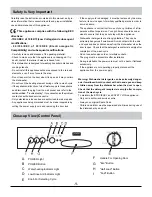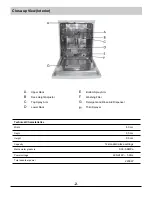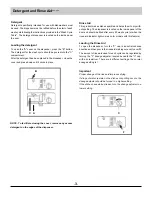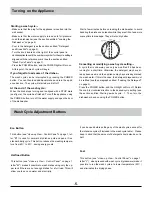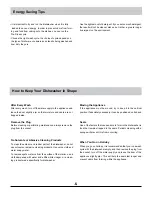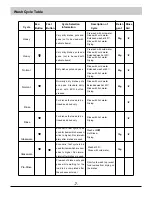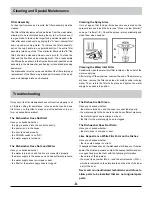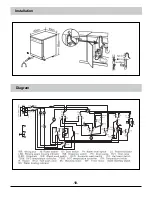
.5.
Turning on the Appliance
Starting a wash cycle
- Make sure that the plug for the appliance is inserted into the
wall socket.
- Make sure that the water supply is turned on to full pressure.
- Load the dishwasher (see the section entitled, "Loading the
Dishwasher" on page 4).
- Pour in the detergent (see the section entitled, "Detergent
and Rinse Aid" on page 3).
- Turn the knob located on the right of the control panel in
clockwise direction until the number or symbol for the cycle setting is
aligned with the reference mark (see the section entitled,
"Wash Cycle Table" on page 7).
- Press the POWER button, and the POWER light will turn on.
At this point, the wash cycle will begin.
Cancelling or modifying a wash cycle setting
A cycle that is underway can only be modified if it has been
running for a short time. Otherwise, the detergent may have al-
ready been used, and the appliance may have already drained
the wash water. If this is the case, the detergent dispenser must
be refilled (see the paragraph entitled, "Loading the Detergent"
on page 3).
Press the POWER button, and the ON light will turn off. Rotate
the knob in clockwise direction to the desired cycle setting (see
the section entitled: Starting a wash cycle
?F
. Then, turn the
dishwasher back on using the POWER button.
If you forget to load some of the dishes
The wash cycle can be interrupted by pressing the POWER
button. You can then load additional dishes and turn the appli-
ance back on. The cycle will start where it left off.
Wait a few minutes before unloading the dishwasher to avoid
handling the dishes and utensils while they are still hot and more
susceptible to breakage. They will also dry better.
Wash Cycle Adjustment Buttons
Eco Button
This button (see "close-up View - Control Panel" on page 1, let-
ter "G" ) is used for normal dirty dishes, pots and pans. It is a
standard daily cycle. This button reduces the washing tempera-
ture from 60
=
to 50
I=
saving energy costs.
Half load Button
This button (see "close-up View - Control Panel" on page 1,
letter "H" ) makes it possible to wash dishes using only the up-
per rack if there are not enough dishes for a full load. This will
allow you to save on water and electricity.
Fast
This button (see "close-up View - Control Panel" on page 1,
letter "I" ) , when pressed with wash cycle 4 (glassware) make it
possible to run the wash cycle at a lower temperature (50
)
and eliminates the drying phase.
It can be used before setting any of the wash cycles, except for
the intensive cycles (if included in the wash cycle table ). Please
keep in mind that the amount of detergent should also be cut in
half.
At the end of the wash cycle
When the knob stops turning and is aligned with a STOP mark
(see figure), the cycle has finished. Turn off the appliance using
the POWER button, turn off the water supply and open the door
of the dishwasher.


